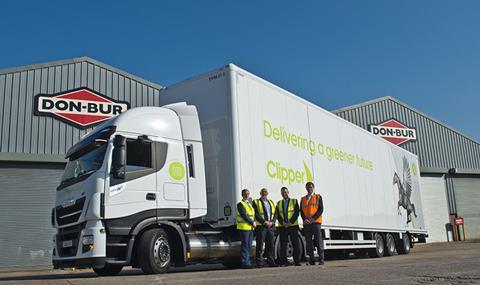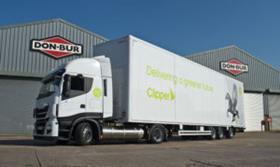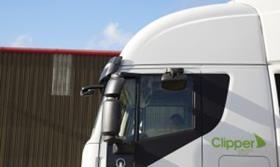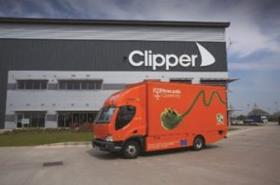
Clipper Logistics has claimed its latest fleet strategy will shave 30% off trunking costs. MT caught up with transport operations director Mick Doe to learn how.
Leeds-based Clipper Logistics has aligned its business model to capitalise on the ever-buoyant e-commerce market, resulting in strong organic growth and a surge of new contract wins.
To complement this growth, Clipper is keen to ensure its fleet is modern, sustainable in operation and can drive further efficiencies for the business.
“We're fully committed to doing what we can on fleet, as we are high mileage road users and have a duty of care to other road users,” said transport operations director Mick Doe (pictured).

“It's the right thing for Clipper to do as a business. We are at the forefront of everything from e-commerce fulfilment through to returns processing and we need to align our fleet strategy to this. It's a logical step for us.”
Fleet additions
The company has introduced 11 liquid natural gas-powered (LNG) IVECO Stralis NPs to its trunking fleet, as well as 16 uniquely designed longer semi-trailers able to carry 60 pallets.
Each gas truck, with a range of 1,500km, is estimated to save around 47 tonnes of CO2 per year, or collectively more than 500 tonnes. Combined with the new longer trailers, they have the capacity to reduce trunking movements by 30%.
They were picked following a successful trial of a 4x2 LNG Stralis NP trunking between Northampton and Scotland on Clipper’s ClickLink operation during November peak last year.
“We did this just to get a feel for how it worked and get some feedback from the driver and about the refuelling process to see if it all worked for us,” said Doe. “The result of the trial was really encouraging. We saw a real running cost benefit from running gas against diesel."
He added: “We also got feedback from the driver who said the vehicle was significantly quieter, smoother and he wasn't as fatigued at the end of his shift.”
The business case
Following the successful on-the-road trial, IVECO dealership Northern Commercials was asked to pull costs together for the switch to LNG.
Whereas the basic lease price per gas truck was more expensive, when running costs and whole-life costs were calculated, a more positive picture emerged for Clipper.

“We found the point where it resonates and you break even is somewhere in the region of about 75,000 miles based on current diesel price vs current gas price,” said Doe.
“So if you are doing mileage above this when you are trunking, then actually it becomes a benefit to run gas, and you can add to this the positives for the driver.”
For one of Clipper’s contracts in particular, the switch to gas was a strong fit: distribution centres are based in Carlisle and outside Cardiff, with goods trunked to outbases for radial deliveries.
Filling up
Refuelling is a major factor in choosing which trunking routes the LNG trucks can operate on, as Clipper relies on public access infrastructure.
“We're in a chicken and egg situation,” said Doe. “There are some LNG sites out there, but you've got to be very careful about the infrastructure and planning which trunking routes it will work on.
“We're working very closely with four or five gas suppliers to tell them what our plans are and find out what they are doing. One's got to overlay the other to make sure we can refuel the vehicle.”
Trailer design
Coupled to the new LNG trucks is an innovative double-deck 15.65m longer semi-trailer.
“We were running standard step-frame double-deck trailers with around a 42-pallet capacity,” said Doe.
“We wanted to find a way to increase the capacity on the trailer that meant doing fewer miles, but that those miles would also be cleaner.”

So Clipper partnered with TIP Trailer Services, Don-Bur and Northern Commercials to work on a new trailer design to boost capacity.
“The big restriction on this was the kingpin height of the vehicle,” said Doe. “Standard in the UK is about 1.25m to the ground from the kingpin, which inhibits your deck height at the front of the double deck.
“So we said to Northern Commercials, if we reduce the kingpin height, could we then get the deck height we need to increase capacity?”
The result was a kingpin height of 95cm, which allowed for an extra 30cm at the front of the trailer. This, in turn, created a 1.83m top and bottom deck height at the front.
Capacity was increased from 42 pallets to 60 pallets - a boost of more than 40%.
The trailers do not cost any more than a standard double-deck LST as less material is used in the build process because they are straight-framed rather than step-framed.
Clipper now leases 16 such longer semi-trailers from TIP and is hoping to increase this allocation to 50 units in the future.
Exploring options
Ensuring its entire fleet is future-proofed and sustainable is essential for Clipper.
Its strategy, where possible, is to move away from diesel into gas or electric when vehicles come up for renewal.
For anything over 75,000 miles a year, LNG will be the fuel of choice due to its proven cost and environmental benefits
However for smaller vehicles, the business case is yet to stack up for Clipper.
“It's difficult, because you've got that threshold of 75,000 miles, but your radial and final mile vehicle are never going to get to that number,” said Doe.
He believes more incentives are needed to boost uptake.
For example, environmental restrictions, such as the London Lorry Control Scheme, prevent trucks from operating overnight in some areas.
“All of this is based on a diesel vehicle rattling around at midnight. A gas vehicle is 50% quieter and an electric 100%. If people started to review this and allow certain vehicles at night, it opens up more opportunities for logistics operators,” Doe added.
“Cities want to drive traffic out of peak time but there is this big barrier that says you're too noisy. If we could utilise our gas vehicle further, for example double-shifting it delivering at night, then this spreads the cost so payback is better.
“It doesn't have to be financial incentives, but just needs thinking about differently.”
Electric avenue
With gas proving a good fit for Clipper’s larger vehicles, Clipper is also looking at options for its mid-

sized trucks, with the mainstay of its fleet comprising 18-tonners delivering into towns and cities.
“We are working with IVECO and are looking at those rigids on contract that are doing more than 75,000 miles, so we could move these to gas as part of the fleet renewal.”
But for the smaller vehicles or those purely working in urban areas, electric is also in the spotlight for Doe.
Clipper has been a long-time operator of earlier-generation electric trucks built by Smith Electric vehicles and operates the units for the Crown Estates in London, and for the Newcastle University consolidation centre (pictured, left).
The early generation trucks are due to be replaced this year with Tevva Motors’ range-extended electric trucks, built in the UK (pictured below). “We've opted for a 12-tonne rigid with a 250-mile range extender," said Doe.
He added: “The interesting thing I found with the electric vehicles is that it completely changes your driving style. If you anticipate and allow the vehicle to brake, it recharges the battery.

“It has a very similar system to KERS in Formula One. You almost change yourself into becoming very proactive and anticipate everything that's going on and use all opportunities to recharge the batteries.”
Hydrogen as an alternative to diesel is not a viable option as far as Doe is concerned as the “costs are just astronomical”.














